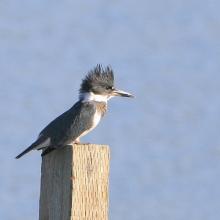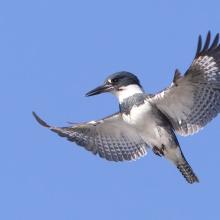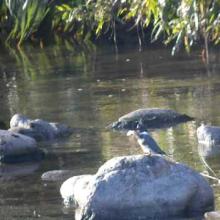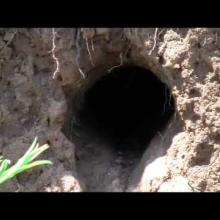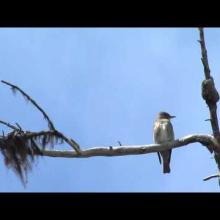

Join BirdNote tomorrow, November 30th!
Illustrator David Sibley and actor H. Jon Benjamin will face off in the bird illustration battle of the century during BirdNote's Year-end Celebration and Auction!
Since it’s often hard to see a bird, veteran birders characterize the sounds of birds in order to identify them. So what words do they use? Well, they use “whistle,” for example, to describe the sound of this Olive-sided Flycatcher. And "rattle" for that of the Belted Kingfisher. There's the trill of a Dark-eyed Junco. And the House Wren's “cascade!" The song of a Downy Woodpecker is a sort of “whinny." Listen again and see if you can recognize the types of sounds.
The Macaulay Library of Natural Sounds supplies many of the sounds for BirdNote, and we are grateful!
BirdNote®
Bird Sound Types and Qualities - I
Written by Chris Peterson
This is BirdNote!
[Song of the Olive-sided Flycatcher]
Since it’s often hard to see a bird, veteran birders characterize the sounds of birds in order to identify them. So what words do they use?
Well, they use “whistle," for example, to describe the sound of the Olive-sided Flycatcher. [Song of the Olive-sided Flycatcher]
What about the sound of this stout little flyer, the Belted Kingfisher? Would you call this a “rattle” or a “trill?" [Call of the Belted Kingfisher] Experienced birders would call it a “rattle." [Call of the Belted Kingfisher]
Now here’s a trill. [Trill of the Dark-eyed Junco] The Dark-eyed Junco delivers an almost perfect trill. Rapidly repeated notes -- at equal intervals -- same pitch -- same speed…[Trill of the Dark-eyed Junco]
What about the song of a House Wren? Would you call this a “trill” or a “cascade?" [Song of the House Wren] A birder with a trained ear would say “cascade."
[Song of the House Wren]
And is the song of a Downy Woodpecker a “cascade” or a “whinny?"
[Whinny call of the Downy Woodpecker] Experience names it a “whinny."
Practice makes perfect, and you can hear them all again at birdnote.org.
That's b-i-r-d-n-o-t-e -- all one word.
I’m Mary McCann. [Song of the Olive-sided Flycatcher]
###
Bird sounds provided by The Macaulay Library at the Cornell Lab of Ornithology, Ithaca, New York. Song of the Olive-sided Flycatcher recorded by T.G. Sander; call of the Belted Kingfisher recorded by S.R. Pantel; song of the Dark-eyed Junco by G.A. Keller; call of the Downy Woodpecker by W.W.H. Gunn; and song of the House Wren by G.A. Keller.
BirdNote's theme music was composed and played by Nancy Rumbel and John Kessler.
Producer: John Kessler
Executive Producer: Chris Peterson
© 2014 Tune In to Nature.org May 2017 / October 2022 Narrator: Mary McCann
073007soundtype1 sound-05b





